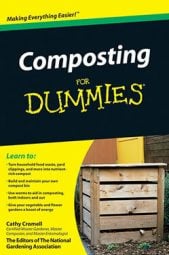Creating a freestanding pile is the easiest method to break into composting. Your freestanding pile must be at least 3 feet x 3 feet x 3 feet (1 cubic yard or 1 cubic meter) up to 5 cubic feet (1.5 cubic meters). This size offers enough mass for the organic matter to self-insulate and maintain moisture and warmth for the microorganisms consuming it.
![[Credit: ©iStockphoto.com/audaxl]](https://www.dummies.com/wp-content/uploads/479249.image0.jpg)
Location is everything, according to realtors, and so it is with your compost pile. An ideal spot is shady (so materials don't dry out), doesn't get inundated with rain (so materials don't get soggy), and is within reach of your hose. It should offer sufficient space for you to work comfortably. Compost at least a few feet away from buildings so moisture from the pile doesn't seep into foundations.
Chop, shred, or break as much of your organic matter as possible into small pieces. The smaller the pieces, the faster the rate of decomposition.
Here are the steps for creating a simple aboveground compost pile.
Spread 4 inches (10 centimeters) of woody, chunky, or coarse brown ingredients, such as straw, corn stalks, or dead perennial stems, as your pile's base.
This rough layer promotes aeration.
Sprinkle each layer with water as you build the pile so that it has the dampness of a wrung-out sponge. Also sprinkle in a few handfuls (or shovelfuls) of native soil here and there.
You don't have to add soil with every layer.
Spread 4 to 5 more inches (10 to 13 centimeters) of brown materials, such as dry leaves or shredded paper.
Spread 2 to 3 inches (5 to 8 centimeters) of green materials, such as spent garden plants and grass clippings.
Continue alternating layers of browns and greens, moistening as you build. Finish up with a layer of browns on top.
You have the option of covering the pile with a tarp. Doing so helps keep materials from drying out in arid regions. In rainy climates, it prevents the pile from getting too wet and turning anaerobic.
The length of time needed to obtain finished compost varies depending on how you mix up the original elements (types of ingredients, size of particles, and moisture levels) and how much turning and remoistening you choose to do after the pile is built.
If you're in no hurry for compost, you can leave the pile sit as is. However, to jumpstart the decomposition process, turn the compost to mix materials on the outside of the pile into the interior so everything decomposes at a similar rate. If you do nothing further after building your pile, in three to six months you'll be able to harvest some finished compost from the bottom and center.

